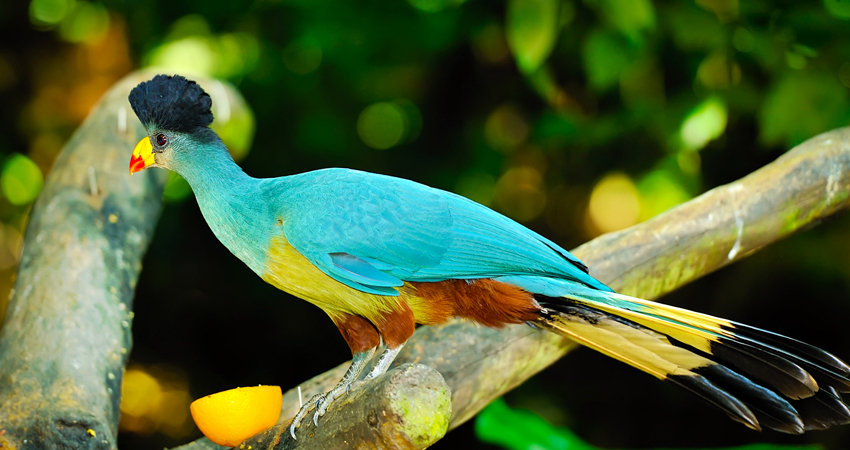
Contents
- 1 DAY 1: NAIROBI – MT. KENYA
- 2 DAYS 2 & 3: MT. KENYA – LAKE NAKURU
- 3 DAYS 4 & 5: LAKE NAKURU – LAKE BARINGO
- 4 DAYS 6 & 7: L. BARINGO – KAKAMEGA FOREST
- 5 DAYS 8-9-10: KAKAMEGA – L. VICTORIA – MASAI MARA
- 6 DAY 11: MASAI MARA – NAIROBI
- 7 DAY 12: NAIROBI – TARANGIRE
- 8 DAY 13: TARANGIRE
- 9 DAY 14: TARANGIRE – SERENGETI
- 10 DAY 15-16: SERENGETI
- 11 DAY 17: SERENGETI – NGORONGORO
- 12 DAY 18: NGORONGORO
- 13 DAY 19: NGORONGORO – NAIROBI
DAY 1: NAIROBI – MT. KENYA
Early departure from Nairobi and head for Mount Kenya National Park arriving in time for lunch. Afternoon will be spent birding along the nearby forested trails, or waiting to view the shy wildlife as they come down to the nearby waterhole/saltlick. We hope to spot some Silvery-cheeked Hornbills, White-starred Forest Robin, Ruppell’s Robin Chat, Olive & Bronze-napped Pigeons, Mountain Greenbul, Stuhlman’s Starling and if lucky, the Verreaux Eagle Owl. Dinner and Overnight at the lodge. (L, D, B)
DAYS 2 & 3: MT. KENYA – LAKE NAKURU
Bird watching in NakuruEarly morning departure and drive across The Great Rift Valley wall and onto the Lake Nakuru National Park, arriving in time for lunch. Here we will enjoy outstanding game drives & bird walks all making this a truly memorable locality. Lake Nakuru is famous for Flamingos, Pelicans and water birds but equally rich in Narina’s Trogon, Arrow-Marked Babbler and Red-Headed Weaver, Hilderbrandt’s Francolin, Montane and Dusky Nightjars and many more.
DAYS 4 & 5: LAKE NAKURU – LAKE BARINGO
After a short drive north, past Lake Bogoria and onto Lake Baringo. We will embark on an afternoon boat excursion to view Hippo, Crocodiles and water birds at close range. Dark Chanting Goshawk, Silver bird, Cliff Chats, Jackson’s & Yellow-Billed Hornbills, Brown-tailed Rock Chat, Bristle-Crowned Starlings, Verreaux Eagle & Spotted Eagle Owl.
DAYS 6 & 7: L. BARINGO – KAKAMEGA FOREST
Take a full day drive over the Tugen Hills, through the Kerio Valley and Sirikwa plateau and finally onto Kakamega Forest. Kakamega is the eastern most remnants of the great West African rain forests that once stretched the width of Africa, its flora, fauna & avifauna is fascinating. Specialties include Great Blue Turaco, Emerald Cuckoo, Blue-headed Bee-Eater, Black & White Casqued Hornbill, Black-billed and Violet’s Black Weavers.
DAYS 8-9-10: KAKAMEGA – L. VICTORIA – MASAI MARA
After an early breakfast take a journey heading south past Lake Victoria, and onto the Maasai Mara, East Africa’s finest wildlife sanctuary. All the big game “Big Five”, Black Rhino, Elephant, Lion, Cheetah, Leopard, Zebra, Wildebeest, Hartebeest, Topi, Eland, Thompson and Grant’s Gazelles, and many more are all well represented alongside local specialties such as Open-billed Storks, Temmick’s Courser, Yellow-throated Sand grouse and Denham’s Bustard. We’ll spend our next four nights at a lodge or Tented camp in Mara.
DAY 11: MASAI MARA – NAIROBI
After an early morning game we will drive back to Nairobi.
DAY 12: NAIROBI – TARANGIRE
After Breakfast you will be picked up from the hotel by a Tourist Shuttle Bus which will transfer you to Tanzania. After finishing with the immigration procedures you will cross into Tanzania arriving in Arusha. After lunch and refreshments you will drive to Tarangire National Park. Situated 114km from Arusha, Tarangire National Park boasts magnificent herds of wildlife. The park gets its name from the river those threads its way through the length of the reserve. It is famous for its dense wildlife population. Thousands of animals – wildebeest, zebra, buffalo, and fringe-eared Oryx – migrate from the dry Masai Mara steppe to the Tarangire River looking for water. Lion and other predators follow the herds.
DAY 13: TARANGIRE
After breakfast you will head out for birding and wildlife viewing in Tarangire National Park. Tarangire is the home of Tanzania’s oldest Elephants and bird life is Prolific too. The endemic Ashy Starling and the rare Yellow colored Lovebird are numerous in Tarangire. You will spend the entire day exploring the bushes in Tarangire.
DAY 14: TARANGIRE – SERENGETI
An Early morning drive to the Serengeti National Park will be our focus of the day, which is actually a continuation of the Masai Mara Eco System. The Serengeti National Park is arguably the best-known wildlife sanctuary in the world. “Serengeti” means “endless plains” in the Masai language and within its boundaries are more than three million large mammals. About 35 species of plains animals can be seen here including the so called “big five” – elephant, rhino, lion (more than 2,000 of them), Leopard and Buffalo. Most of the plains game congregates in Southern Serengeti, followed by their attendant predators. Some time in May or June the herds migrate North and West in search of water.
They remain in North Serengeti and the western corridor during the dry season, July-October, returning South again as the November rains approach. The Wildebeest calving takes place on the short grass plains during late December – early February. In their wake follow the predators; lion cheetah and hunting dogs with vultures circling overhead. Other common species found here include hippo, giraffe, eland, impala and other antelope types, baboons, monkeys and a profusion of almost 500 bird species.
DAY 15-16: SERENGETI
This morning you will have an optional pre breakfast opportunity to walk around the camp grounds birding, being escorted by a local resident Masai tribesman. You will then embark on a full day on the Serengeti Plains exploring the entire park and as well searching for the two Endemic birds on the plains, which include the Grey Breasted Spur fowl, and the Fisher’s Lovebird.
DAY 17: SERENGETI – NGORONGORO
After an early game drive and all the wildebeest migration excitement, you will then drive out of the Serengeti plains into the famous Ngorongoro Crater.
Listed by Unesco as a world heritage site, the incomparable Ngorongoro Crater is the world’s largest “caldera”. A caldera is the broad, crater-like basin of a volcano formed by the collapse of the central cone. Dominated by cliffs standing some 600 meters high and presenting a sheer drop down to a wide open space of some 264 square km, the crater is one of the most amazing sights seen anywhere. The Crater is home to 25,000 larger mammals, almost half of them zebra and wildebeest. There are also gazelle, buffalo, eland, hartebeest and wart hog. Such vast numbers attract predators a plenty, mainly lion and hyena but also cheetah and leopard. More than 100 species of birds not found in the Serengeti have been spotted here. Countless flamingos form a pink blanket over the soda lakes. Our next night will be at the Ngorongoro Wildlife Lodge.
DAY 18: NGORONGORO
We will spend the whole day with picnic lunches exploring the wonders of Ngorongoro on the Crater floor taking our last wildlife pictures before returning at the lodge for Dinner and Overnight at the Ngorongoro Wildlife Lodge.
DAY 19: NGORONGORO – NAIROBI
Today you will leave Ngorongoro after breakfast and be transferred to Arusha. After lunch you will be transferred to Nairobi by a Tourist Shuttle Bus or you will be transferred to Kilimanjaro Airport for your outbound flight depending on your flight arrangements.
NB:Safari Cost on request – Price depends on choice of accommodation, number of safari participants and prevailing exchange rates
TOUR PRICE INCLUDES
- Accommodation in Safari Lodge, Camp or Campsite as per itinerary
- All meals as per safari itinerary
- Accommodation in double/twin/triple room sharing.
- All park entrance fees to include government taxes
- Service of an English/German/French/Italian speaking professional Safari driver/guide.
- Safari Game drives as detailed in the itinerary.
- Transport in a safari tour mini bus with a game viewing roof hatch and VHF radioTOUR PRICE EXCLUDE
- Tips and other gratuities
- Things of a personal nature
- Drinks.




